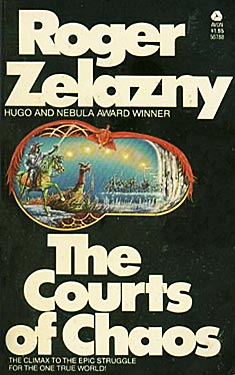Roger Zelazny
Completed 9/13/2020, Reviewed 9/13/2020
4 stars
This was a rousing conclusion to
the Corwin Cycle of the Chronicles of Amber.
It had action, adventure, magical beings, and a dramatic ultimate
scene. The prose was a little more
flowery, but still pretty tight. All the
characters were well established and acted in keeping with who they are. My only complaint was that the pacing was a
little uneven in the middle. There’s a
long set of scenes where Corwin has to journey from Amber to the Courts of
Chaos. He meets many magical beings, but
in between these scenes, the descriptions of the lands Corwin was going through
as well as his state of being got a little dry.
Otherwise, I really enjoyed this book and found the ending to be quite exhilarating.
Warning: Spoilers from the previous books follow!
The book picks up with Corwin back
in Amber with his father Oberon back under the guise of Ganelon. Oberon gives orders for all his children on
what to do while he tries to repair the Pattern that Brand has corrupted. The Pattern is the design from which all realities
and shadows emanate. Oberon offers
Corwin the throne of Amber, but he refuses, realizing he doesn’t really want it
anymore. So Oberon sends him off to the
Courts of Chaos to do battle using the Jewel of Judgement once Oberon is done
with it in his quest to repair the Pattern.
Oberon believes whether he succeeds or fails with the Pattern, the task
will kill him. Corwin begins his journey,
eventually receiving the Jewel from a red raven his father created. Thinking his father failed, he realizes he
must try to create a new pattern and return the universe to normalcy.
One of my favorite parts of this
book was Corwin coming across the magical beings. In one scene, he meets a cave of leprechauns
who are about to eat his horse. In
another, he makes a staff from the talking tree named Ygg, an allusion to the
Yggdrasil, the tree of life, of Norse Mythology. Then he meets and accompanied by a talking raven
named Hugi, an allusion to Huginn, one of the ravens of Odin, also of Norse
Mythology. I’ve always liked how Zelazny
borrowed from different religions for his books, like Greek Mythology in This Immortal and Hindu and Buddhism in Lord of Light.
I also liked the dramatic ending
of the book. I won’t give it away, of
course, but I thought Zelazny’s descriptions were very vivid for the fantastical
events that took place. The action was
tightly written as well.
Overall, this series was quite a
thrill ride. There’s definitely a change
in tone as the series progresses. The
first two books, Nine Princes in Amber and The Guns of Avalon, are very typical
Zelazny. The Sign of the Unicorn,
however, is the book that feels different, becoming more philosophical in
nature, and a little slower paced. The Hand of Oberon continues this philosophical tone but picks up with the action
and the tightness of the prose, continuing and culminating in this final
book. My understanding is that the
second half of the Chronicles, the Merlin Cycle, again has a different tone and
feel, it being published after a seven-year gap, between 1985 and 1991.
I give this book four stars out of
five. The book is a worthy conclusion to
an amazingly complex and imaginative work.
I’m glad I finally read it. I
think I’m going to save the Merlin Cycle for next year, giving myself a break
and a chance to be open to the differences in its tone and style compared to
these books.

No comments:
Post a Comment